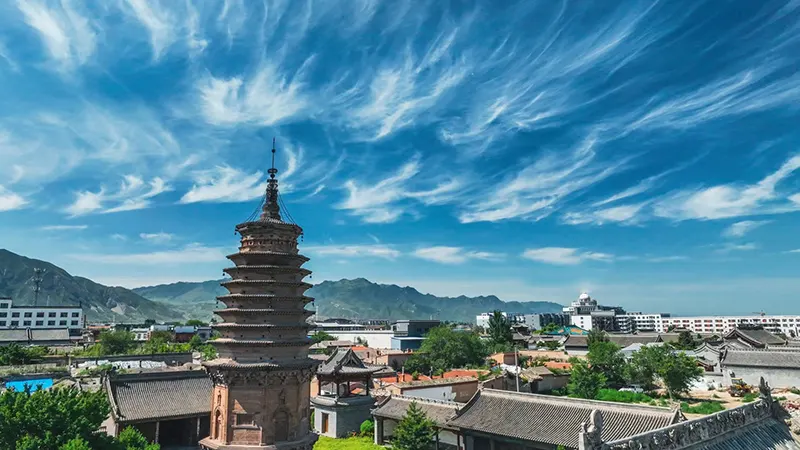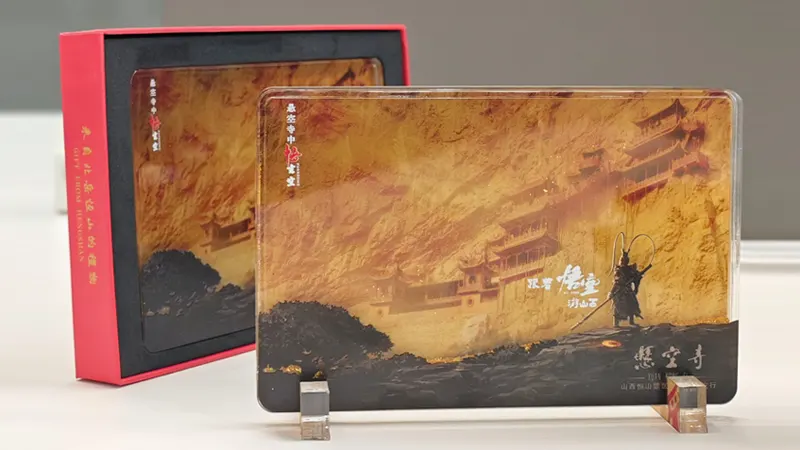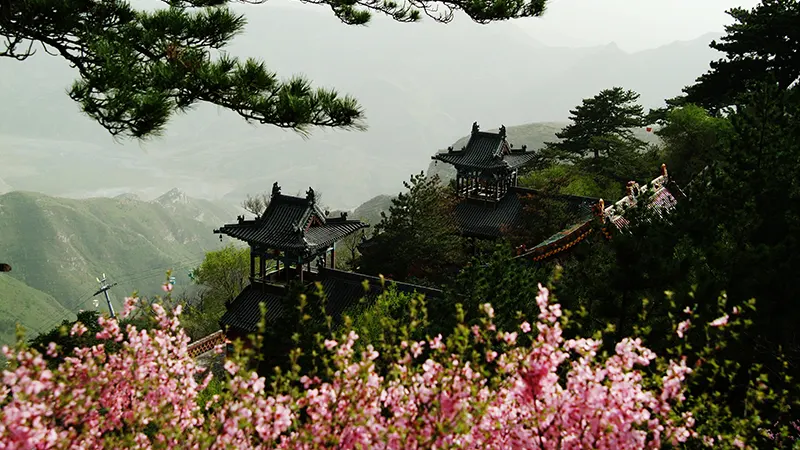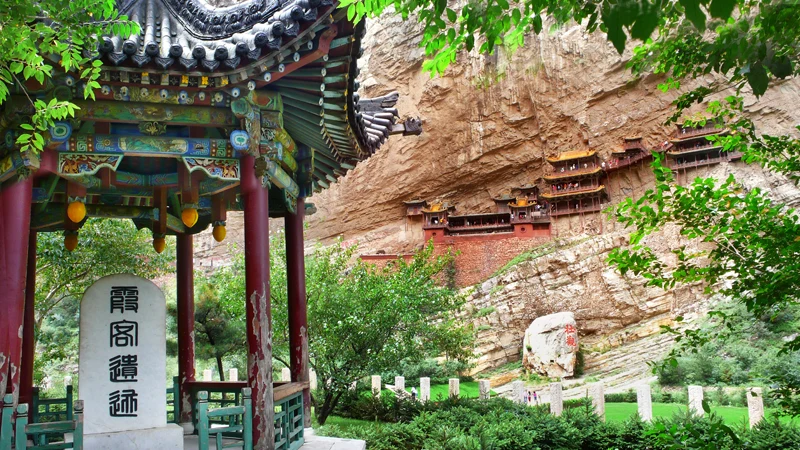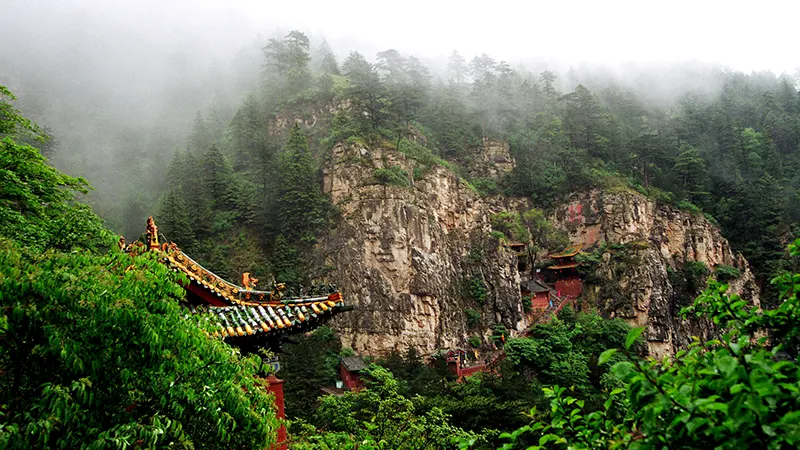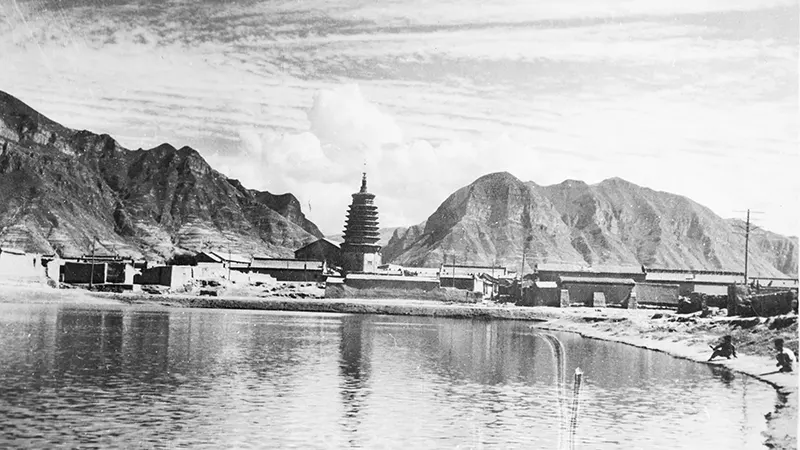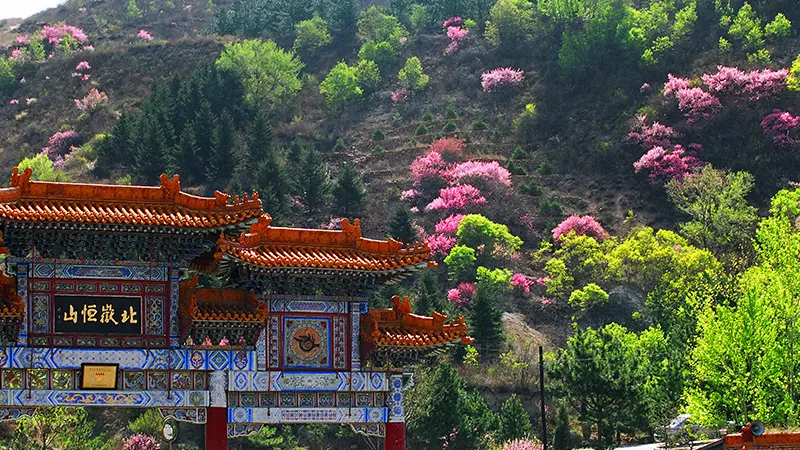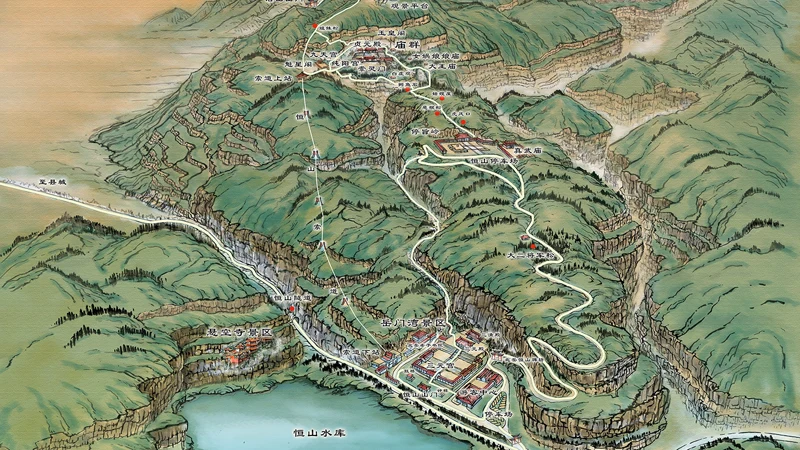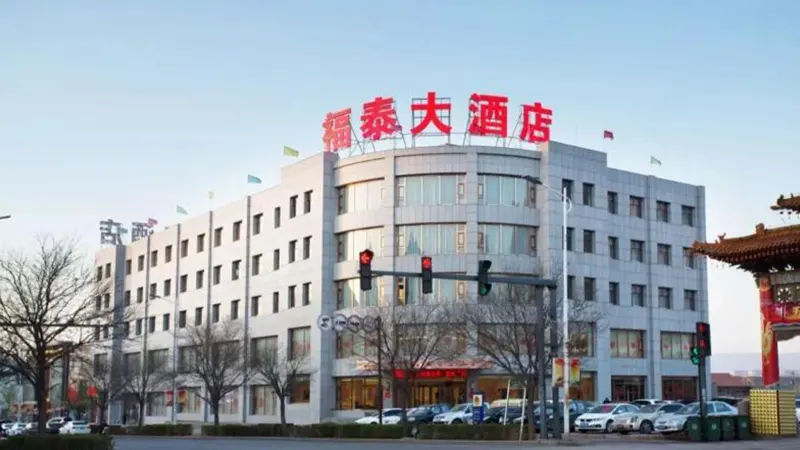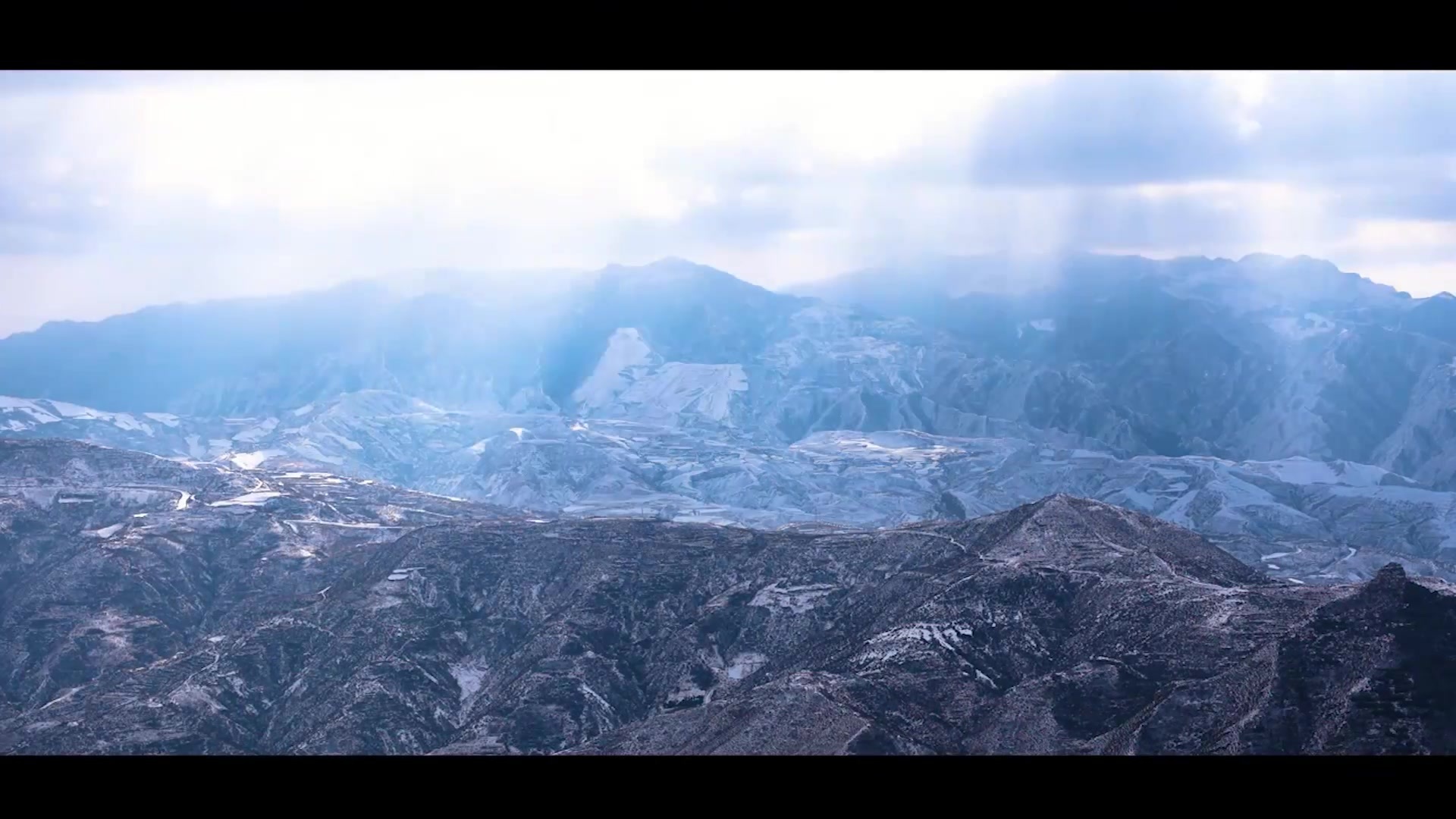Shanxi's only "national mountain": Hengshan Mountain
Publish Time:
2025-03-14 16:45
Source:
There are five sacred mountains in China, and Hengshan Mountain is the northernmost. Its peaks and ridges rise in countless layers, mysterious and unpredictable." Many scholars who have visited Hengshan Mountain in Hunyuan County, Datong City, Shanxi Province, share a common understanding: Hengshan Mountain deserves the title of China's "national mountain" and is worthy of pilgrimage by every Chinese citizen.
“There are five sacred mountains in China, and Hengshan Mountain is the northernmost; its peaks and ridges rise in countless layers, mysterious and unpredictable.” Many scholars who have visited Hengshan Mountain in Hunyuan County, Datong City, Shanxi Province, share a common understanding: Hengshan Mountain deserves the title of "National Mountain" of China and is worthy of reverence by every Chinese. Why is this so? Allow me to explain in detail.
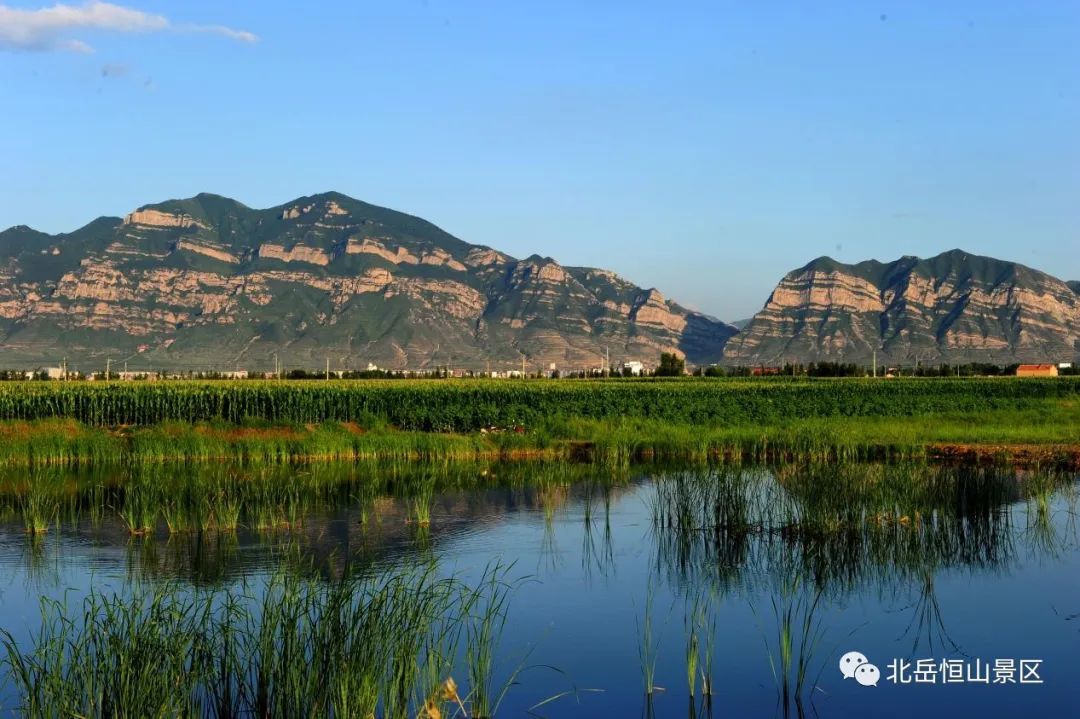
National A national mountain must be a place for the worship of emperors, and Hengshan Mountain is where the Emperor Zhuanxu was worshipped. An ancient saying states: "The most important matters of state are sacrifices and warfare" (Zuozhuan, Duke Cheng, Year 13). Emperors throughout ancient China would offer sacrifices to the Five Sacred Mountains, the Four Great Rivers, and the ancestors of the Chinese people. The Shangshu, Emperor's Canon, records: "In the eleventh month of Shun's reign, he made a tour of inspection and reached the Northern Sacred Mountain." The Shangshu, Yu Gong, Dao Shan, records: When Emperor Qin Shi Huang made his eastern tour, he passed "Taihang Mountain and Hengshan Mountain, reaching Jie Shi and entering the sea." The Qian Hanshu records: In the third month of spring in the third year of Emperor Wu of Han's reign (98 BC), he went to Mount Tai to perform a sacrifice, and then personally came to Hengshan Mountain to perform a sacrifice, performing the "Yi Yuanyu" ritual, and for the first time, conferred divine status upon Hengshan Mountain. The Weisushu, Rituals, records: In the Xinwei year, he went to the Dai region, reached the Yanmen Pass, and offered sacrifices to Hengshan Mountain. The following year, the emperor made a southern tour, passed Shimen, and sent envoys to offer jade bi and sacrifices to Hengshan Mountain. The Suishu, Volume 7, Chapter 2, records: Emperor Yang, while visiting Jinyang, also offered sacrifices to Hengshan Mountain. The Three Sovereigns and Five Emperors are the common ancestors of the Chinese nation, and the Northern Sacred Mountain Emperor Zhuanxu was one of the Five Emperors of antiquity. Zhuanxu was the grandson of the Yellow Emperor, of the Ji surname, and one of the ancestors of Chinese civilization. Zhuanxu was an emperor with achievements in civil administration. At the age of fifteen, he assisted Shaohao in governing the Jiu Li region and was enfeoffed in Gaoyang (present-day Qixian County, Henan Province), hence he was also known as Gaoyang. After the death of the Yellow Emperor, due to Zhuanxu's virtuous character, he was made emperor at the age of twenty and ranked as one of the Five Emperors. During his reign, Zhuanxu created the Nine Provinces, giving China its first territorial boundaries; he established a ruling institution, established marriage customs, studied the differences between men and women, and established order between elders and juniors; he reformed the Jia calendar, establishing the four seasons and the twenty-four solar terms. Later generations revered him as the "Ancestor of the Calendar." Zhuanxu was the Heavenly Emperor who governed the north. In ancient times, Hengshan Mountain was his residence. According to the Five Elements theory, the north is represented by Xuan (black), so Zhuanxu was also called the "Black Emperor." According to the Daozang scriptures, the gods of the Five Sacred Mountains each govern the myriad things in the world. Among them, the Northern Sacred Mountain Emperor governs the rivers and seas, and four-legged creatures, meaning that the Northern Sacred Mountain Emperor Zhuanxu is not only our ancestor of civilization and the Xuanwu Emperor, but also the water god who governs the land of China. The Tao Te Ching states: "The highest good is like water," "Water benefits all things without contention, dwelling in places that people dislike, thus approaching the Tao." Therefore, the Northern Sacred Mountain Emperor represents the Tao of Heaven and Earth, benefiting all things; Hengshan Mountain is a place of supreme goodness, holding the highest position among the famous mountains of China.
A national mountain must be a place of communication with heaven where a noble goddess is worshipped, and Hengshan Mountain is where the Yellow Emperor's teacher—the Nine Heavens Profound Girl—is worshipped. The Nine Heavens Profound Girl, also known as Xuan Nu, is commonly called the Nine Heavens Profound Girl Madam. She was the teacher of the Yellow Emperor and a disciple of the Holy Mother Yuanjun. The Holy Mother Yuanjun is Laozi's mother and the highest-ranking female immortal in Taoism. It is said that the Nine Heavens Profound Girl was highly skilled in martial arts, proficient in magic, and had the ability to predict the future. Sometimes she held a "heavenly book," appearing as a messenger conveying the will of Heaven to the world on behalf of the Holy Mother Yuanjun. The Han Dynasty's book Longyu Hetu records: Heaven sent the Profound Girl down to give the Yellow Emperor military strategies and divine talismans to subdue Chi You. Without the help of the Nine Heavens Profound Girl, the Yellow Emperor would not have unified the world. The Nine Heavens Profound Girl Temple on Hengshan Mountain is the ancestral temple of all Nine Heavens Profound Girl Temples in China. Women naturally bear the sacred responsibility of human reproduction, and the goddess is the representative of the human mother, the incarnation of the goddess who bestows children. Therefore, the Nine Heavens Profound Girl Temple on Hengshan Mountain is not only the ancestral temple of all Nine Heavens Profound Girl Temples in China, but also a temple where believers pray for children, and even overseas Chinese consider visiting the Nine Heavens Profound Girl Temple on Hengshan Mountain a fortunate event in their lives. Similarly, Mount Tai, like Hengshan Mountain, as a national mountain of China, also worships another noble goddess who communicates with heaven—Bi Xia Yuanjun. In Hunyuan County, there are goddesses in the heavens and beautiful women on earth. There is a folk saying in Hunyuan County: "When you arrive in Hunyuan Prefecture, you will divorce your wife." This means that the girls in Hunyuan are all beautiful and charming. Tourists who come to Hunyuan are captivated by the beauty of Hunyuan and forget to go home. The reason why Hunyuan girls are beautiful is: firstly, because Hunyuan girls drink the sweet spring water of Hengshan Mountain and bathe in the water of "the first spring in the north"—Tangtou Hot Spring, their skin is nourished and fair; secondly, because Hunyuan girls often eat selenium-rich Hengshan Mountain mushrooms, their complexions are rosy and healthy, without the need for makeup, full of natural beauty; thirdly, because Hunyuan girls are all clever and hardworking, proficient in embroidery, cooking, and housework. Before marriage, they are good daughters and helpers to their mothers, and after marriage, they are good wives and mothers in their families; fourthly, because Hunyuan girls are all "near the water tower and get the moon first," they are bestowed by the Nine Heavens Profound Girl Madam, inheriting the beauty of the goddess of Hengshan Mountain, each possessing a beautiful face comparable to that of a fairy.

A national mountain must be one of the origins of Eastern civilization, and the Liyu painted pottery cultural site and the Liyu bronze ware site on Hengshan Mountain are two important remnants of ancient Chinese civilization. The Liyu Painted Pottery cultural site is located on the south side of Miaopo Hill in East Bay Village, a natural village in Liyu Village, Dongfangcheng Township, Hunyuan County. It was discovered by Mr. Bai Wanyu of the Institute of Archaeology, Chinese Academy of Sciences. After examination by renowned Chinese archaeologist Mr. Pei Wenzhong and others based on the shape, color, rope patterns, and thickness of the artifacts, it is believed to have been influenced by the Yangshao culture (dating back 7000 years) and the Longshan culture (dating back 4000 years). The Longshan culture period corresponds to before the Xia Dynasty as recorded in historical documents, or possibly slightly overlapping with the early Xia Dynasty. Mr. Jiali Ji, a member of the French Academy and director of the Jimei Museum, commented: “The bronze vessel was exhibited at the Jimei Museum for three months…French audiences will discover the exquisite craftsmanship of Chinese bronze artisans during the Spring and Autumn period.” This bronze vessel, a masterpiece representing the second peak of the Chinese Bronze Age, a unique bronze artwork in the world, and the treasure of the Shanghai Museum, was unearthed from the Liyu Bronze Ware site at the northern foot of Hengshan Mountain. According to relevant materials, there are about sixty or so bronze artifacts that have surfaced, are known, and are relatively well-preserved (including those transported to France, those confiscated by the county government office, and those in museums in the United States, Sweden, Germany, and the United Kingdom). Currently, the whereabouts of more than forty are known, and they are respectively housed in the Shanghai Museum, the National Museum of China, the National Palace Museum in Taipei, the Musée Guimet in France, the Freer Gallery of Art in Washington, D.C., the Metropolitan Museum of Art in New York, the Kronos Oriental Art Museum in Germany, and other places. These Liyu bronze wares, renowned for their vivid shapes, exquisite patterns, and fine casting techniques, are like a pearl embedded in the crown of Chinese bronze art. They have shaken off the dust of history, revealing their brilliant luster, and showcasing the unique, profound, vast, long, and splendid civilization of Hengshan Mountain culture in the world’s community of nations!

Hengshan Mountain must be a place where the great achievements of Chinese culture are gathered; it is a typical representative of the fusion of Buddhist, Taoist, and Confucian cultures. The Buddhist, Taoist, and Confucian cultures, abandoning conflict and embracing development, have formed the main vein and genes of excellent traditional Chinese culture. Hengshan Mountain is the birthplace of the Quanzhen School of Taoism. Wang Chongyang, the founder of the Quanzhen School, advocated "the unity of the three religions," saying, "The Confucian gate, the Buddhist temple, and the Taoist path are interconnected; the three religions have always originated from one ancestor." Hengshan Mountain has a Hanging Temple, originally named Chongxu Temple, built on the sheer cliffs of the Golden Dragon Gorge between the Tianfeng Ridge and Cuiping Peak, the main peaks of Hengshan Mountain. It is a group of three-story vermilion buildings supported by 90 vertical pillars of varying lengths. It was originally built in the later years of the Northern Wei Dynasty during the Taihe 15th year (491 AD), more than 1500 years ago, and has been rebuilt during the Tang, Song, Jin, Ming, and Qing dynasties. The Hanging Temple is one of the rare cliffside ancient buildings in the world, known as the "miraculous pavilion in the air" and "the first sight of Hengshan Mountain." It was also named one of the world's ten most illogical "dangerous" buildings by Time Magazine. When the great Tang Dynasty poet Li Bai visited the Hanging Temple, he marveled at its magnificence and wrote the poem "Night Lodging in a Mountain Temple": "A dangerous building a hundred feet high, I can reach out and pick the stars. I dare not speak loudly, for fear of startling the heavenly people." On the highest level of the Hanging Temple, there is a Three Religions Hall, where one can appreciate the cultural wonder of Wang Chongyang's advocacy of "the unity of three religions." In the Three Religions Hall, Confucius, Sakyamuni, and Laozi are enshrined together. Buddhism emphasizes compassion, universally saving sentient beings; Confucianism emphasizes harmony and goodness, benevolence loving people; Taoism emphasizes emptiness, acting in accordance with nature. The three religions, though different, complement each other and coexist peacefully, fully reflecting the broad mind and grand demeanor of Chinese culture in embracing all kinds of cultures. Therefore, Xu Xiake, a geographer of the Ming Dynasty, called the Hanging Temple of Hengshan Mountain "a magnificent sight under heaven" in his "Travels of Xu Xiake." Lu Shoumings, a Jinshi scholar and professor of Ningguo Prefecture during the Qing Dynasty, praised it as "truly a marvel of great skill and wonder under heaven" in his "Continuation of Taiping Guangji." A Thai princess exclaimed it was a “Buddhist heart manifested in the sky.” In addition to the Hanging Temple, the phenomenon of the fusion of the three religions is everywhere on Hengshan Mountain. For example, the Pure Yang Palace and the Guan Yu Temple, representatives of the fusion of the three religions, silently tell visitors stories of the fusion of the three religions in the Chinese nation.
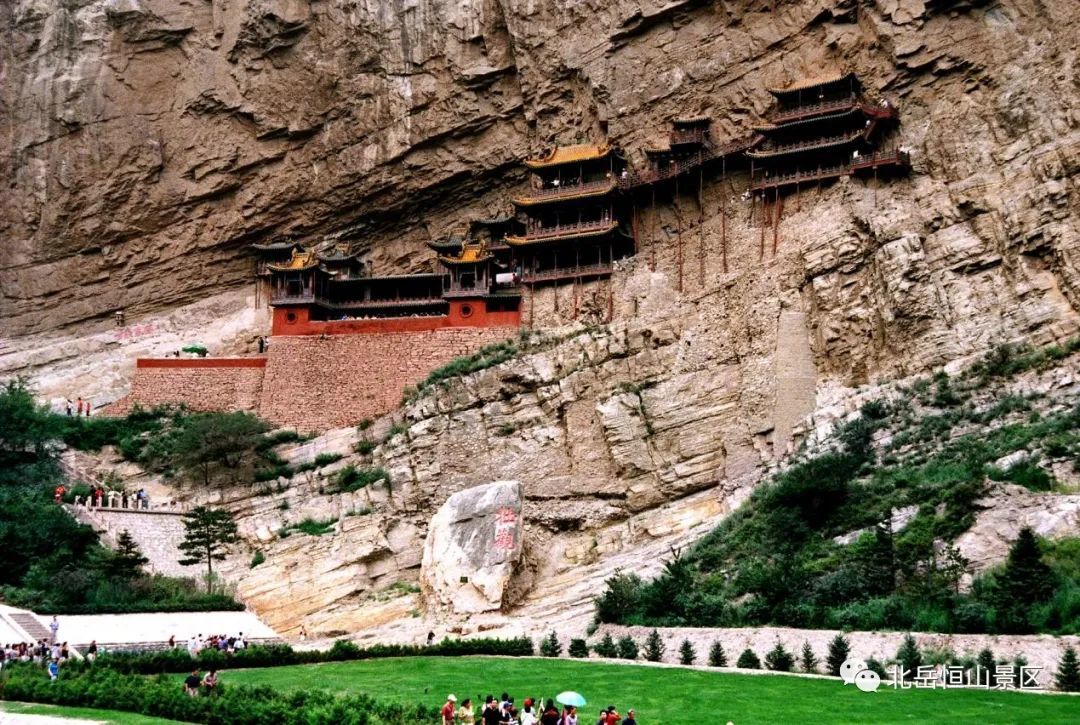
Hengshan Mountain has always been a battleground throughout history; its perilous nature can break the back of the world. Hengshan Mountain is located in a strategic location between the northern frontier and the Central Plains. Many familiar passes such as Pingxing Pass and Yanmen Pass are located here, making it a battleground since ancient times. Many emperors and famous generals have fought here. In the Spring and Autumn Period, the State of Dai relied on Hengshan Mountain to exist; in the Warring States period, Yan and Zhao relied on Hengshan Mountain to establish their states; in the Han Dynasty, the Xiongnu used Hengshan Mountain to compete for the world; during the Eastern Jin Dynasty, the Murong clan controlled Hengshan Mountain to command the world; during the Northern Wei Dynasty, the Tuoba clan depended on Hengshan Mountain to divide the world; in the Song Dynasty, the Zhao family relied on Hengshan Mountain to defend the world; in the Jin Dynasty, the Jurchen people relied on Hengshan Mountain to control the world; in the Yuan Dynasty, the Mongols marched south from Hengshan Mountain to conquer the world; in the Ming Dynasty, Xu Da used Hengshan Mountain to ensure the stability of the Ming Dynasty. The Qing Dynasty unified the country also by relying on the natural barriers along the Great Wall, with Hengshan Mountain as its main component. If you are a drone enthusiast, when you control a drone for aerial photography over Hunyuan, you will find that sections of the Great Wall winding over Hengshan Mountain, age-old fortresses, and beacon towers, their outer walls weathered and dilapidated yet stubbornly standing, are visible everywhere in Hunyuan County…This bears witness to the ancient and magical nature of the Northern Mount Tai land and the frontier Hunyuan, telling the extremely tortuous and rich frontier spirit of Hunyuan.

Hengshan Mountain must be a place where rare treasures are produced. At the foot of Hengshan Mountain, with its excellent ecological environment, grows the best "Astragalus membranaceus, Hengshan mushroom, and Ganoderma lucidum" in all of China, known as the "Three Treasures of Hengshan Mountain". Hengshan Mountain boasts a long history of Astragalus cultivation, renowned for its superior quality and high recognition. It's designated as a "National Authentic Herbal Medicine Base" and a "National Traditional Chinese Medicine GAP Cultivation Base," enjoying high prestige both domestically and internationally. Academician Xiao Peigen, a renowned pharmaceutical expert and known as the "Father of Astragalus Research," has determined through years of study that Hengshan Mountain Astragalus exhibits significantly higher levels of saponins, flavonoids, and polysaccharides compared to similar Astragalus from other regions, truly deserving its titles of "Number One in the World" and "Home of Astragalus." Mushrooms grown in Hengshan Mountain, commonly known as "Heng Mo," are highly nutritious edible fungi, also called "Tian Hua Cai," and a rare specialty of Hengshan Mountain. Main varieties include: Lentinula edodes, Autumn Dew White, Silver Plate, and Dog Paw. Characteristics of Heng Mo include: tender texture, milky white color, large fruiting bodies, high oil content, strong aroma. They can be cooked into various meat and vegetable dishes, making them a prized delicacy. The best quality Heng Mo originates primarily from Tianfeng Ridge, Qianfo Ridge, Lotus Mountain, and the surrounding mountains near Wutai Mountain in the Hengshan Mountain range. Dishes made with them are elegantly colored, taste fresh and delicious, and have a tender, crisp, and smooth texture. The Yuan Dynasty's Wu Rui's "Daily Use Materia Medica" describes Hengshan Mountain mushrooms as follows: "shaped like pine flowers but larger, fragrant like mats, white, and delicious to eat." They were selected as a court dish during the Northern Wei Dynasty and are a famous traditional specialty of the Sanjin region. Hengshan Mountain has historically produced Ganoderma lucidum. Hengshan Mountain has "Eighteen Views," one of which is Zi Zhi Yu, named for its Ganoderma lucidum production. Ganoderma lucidum, also known as Yuan Zhi and Zi Zhi, is said to have life-saving and longevity-promoting effects. In the 35th year of the Jiajing reign of the Ming Dynasty, an imperial edict was issued to search for Ganoderma lucidum on the mountains near the Bei Yue Temple in Quyang, Hebei, but none was found. Emperor Jiajing then dispatched officials to Hengshan Mountain in Hunyuan to collect Ganoderma lucidum, and they successfully collected twelve specimens in Zi Zhi Yu, resembling cloud brocade, all of the highest quality, which were presented to the emperor. Since then, Ganoderma lucidum was collected and presented annually. It is said that each Ganoderma lucidum was guarded by a two-headed snake, making them very difficult to collect. Only sacred mountains produce Ganoderma lucidum, and the collection of Ganoderma lucidum on Hengshan Mountain is one of the important reasons why Hengshan Mountain's worship was changed back to Hunyuan Hengshan Mountain.
A sacred mountain must be accompanied by sacred water, and Hengshan Mountain's beauty is matched by the beauty of its water. The Hunyuan County, where the main peak of Hengshan Mountain is located, also derives its name from water; it is said to be named after the confluence of eight streams from the south of Hengshan Mountain. The water of Hunyuan is also particularly magical: Hunyuan Tangtou Hot Spring is the number one spring in North China, with significant health and wellness effects. It once housed a Northern Wei imperial palace, where emperors and empresses bathed and spent summers; Hunyuan Shenxi Wetland is a national wetland park, with blooming lotuses and swans, offering breathtaking scenery; Hunyuan Hengshan Mountain Lake is an arch dam reservoir designed and built by Qian Zhengying, China's first Minister of Water Resources, featuring a hanging temple waterfall, a flying bridge, and stunning lake and mountain scenery, a true mountain and water paradise; Hunyuan Ganquan-brewed Hunyuan wine is clear, pure, mellow, sweet, soft, naturally harmonious, and has a long-lasting aftertaste. There is an old saying: "Inhale the water smoke under Lanzhou, drink the spirits of Hunyuan Prefecture," and it once won a gold medal at the Panama International Exposition. Since ancient times, Hunyuan County has been guarded by two water gods: one is Xuanwu Emperor—Zhuanxu, and the other is the Shenxi Water God—Lü Lǚ. Some say that the reason why the water in the Hengshan Mountain area is so good is because these two water gods reside here.

A sacred mountain must be able to gather skilled craftsmen to produce exquisitely crafted national treasures. Hengshan Mountain possesses numerous treasures created by master artists throughout the ages, including "the large characters of Xue'an, the emperor's plaques, the glittering murals of Yong'an Temple; the porcelain of Jie Zhuang, the bells of Shenxi, and the sand-cast Buddha statues of the Hanging Temple." The lintel of the Chuanfa Zhengzong Hall within the Yong'an Temple, a national preservation unit, displays a large plaque inscribed with the six characters “Chuanfa Zhengzong zhi Dian” (Hall of the Authentic Transmission of the Dharma). The characters are carved in relief on wood; the font is square and regular, with strong and vigorous brushstrokes, combining the styles of Yan Zhenqing and Liu Gongquan. It is the work of Xue'an, a high-ranking monk and renowned calligrapher of the Yuan Dynasty. His large-character calligraphy is particularly rare; Xu Bangda of Donghai praised his calligraphy as comparable to that of Yelü Chucai. The great calligrapher Zhao Mengfu exclaimed that Xue'an's large characters were unsurpassed in the contemporary world, surpassing even his own. Xue'an, also known as Shi Puguang (or Puguang), whose courtesy name was Xuanhui, was a native of Datong. He was well-versed in classics, history, philosophy, and literature; his poems were refined and elegant; his calligraphy was forceful and magnificent; he also excelled in painting. He was conferred the title of Grand Academician of the Zhaowen Hall and the honorific title of Xuanwu Master by Emperor Shizu of the Yuan Dynasty. Hengshan Mountain Temple houses two imperial plaques from the Qing Dynasty. One is inside the main hall, hanging high above the statue of the Sacred Emperor of Mount Tai, bearing the inscription “Hua Chui Youjiu” (Enduring Transformation) written by the Kangxi Emperor. The second hangs in the center of the Madian Mountain gate, bearing the inscription “Ren Tian Bei Zhu” (Pillar of Heaven and Earth in the North) written by the Daoguang Emperor. The calligraphy of the Kangxi Emperor is stately and luxurious, while that of the Daoguang Emperor is elegant and refined; they are masterpieces of imperial calligraphy. The murals in Yong'an Temple are believed to have been initially painted in the Yuan Dynasty, with many sections repainted in the Ming and Qing Dynasties. The huge, intricately detailed and brightly colored murals covering the four walls measure 3 meters in height and 56 meters in length, with a total area of 186.09 square meters, depicting 895 figures from the three realms of heaven, earth, and humanity. The entire mural, with gold inlay and bright colors, features vigorous and flowing brushstrokes, brilliant and luxurious colors, and meticulous depictions of figures with vivid expressions. It is one of the extremely rare surviving mural masterpieces in China. The celadon wares produced at kiln sites such as Jiezhuang in Hunyuan County are one of the representative varieties of northern Chinese celadon, renowned for their fine texture, clean and flowing lines, simple and dignified shapes, and pure yet varied colors. Among them, inlaid celadon is an extremely rare type in previous ceramic archaeological discoveries. People often use the phrases “thousands of peaks in emerald green” and “pearls of the porcelain sea” to describe the beauty of this celadon glaze. Hunyuan kilns also produced famous white porcelain, representing one of the northern white porcelain varieties in the famous "South blue, North white" classification of Chinese porcelain. Hunyuan kilns were one of the main production sites of black glaze ceramics. The black porcelain produced there was one of the most commonly used glaze colors in ancient northern Chinese ceramics. The black glaze carved-flower porcelain is the most decorative and artistically accomplished variety among black glaze porcelain; it has been praised by the expert Mr. Meng Yao Hu as "as black as lacquer, even and delicate," a unique treasure of the JIN Dynasty folk ceramic kiln decoration art of Shanxi. The casting of bells in Shenxi has a long and glorious history, with exquisite craftsmanship. It is known for its longevity, influence, and high value, representing an important traditional folk handicraft. According to the identification and determination of experts and scholars from the Chinese Academy of Sciences and the Shanxi Provincial Archaeological Research Institute, the bell-casting techniques in Hunyuan are inextricably linked to the ancient pagoda base ruins on the top of the Yungang Grottoes in Datong, Shanxi, originating in the Liao and Jin dynasties, and dating back about 1,000 years. This important traditional folk handicraft was listed in the provincial intangible cultural heritage register in 2011. The Hanging Temple contains artifacts of extremely high value. The temple houses 78 statues of various types, including bronze, iron, stone carvings, and clay sculptures. Among them, the three de-lacquered Three Buddhas statues enshrined in the Three Buddhas Hall were made in the Tang Dynasty, employing sophisticated de-lacquered sculptural techniques. Most early Chinese de-lacquered Buddhist statues are now overseas; the Metropolitan Museum of Art and the Seattle Art Museum in the United States each possess a Tang Dynasty de-lacquered seated Buddha statue. The Nara Todai-ji Temple in Japan still preserves a de-lacquered statue of Jianzhen, a testament to Jianzhen’s transmission of sculptural techniques from China. The three Tang Dynasty de-lacquered Three Buddhas statues enshrined in the Three Buddhas Hall of the Hanging Temple are exquisitely crafted, solemn and compassionate, weighing only 2.5 kilograms, and are rare treasures.

The beauty of Hengshan Mountain cannot be described in a few days and nights. Even this brief description shows its splendor, proving that Hengshan Mountain is a representative of China's beautiful mountains and rivers, a symbol of the country's prosperity, a carrier of national heritage, and the "national mountain" and "sacred mountain" of the Chinese nation. It is a shared natural and cultural heritage of all humankind, holding an extremely high status in the hearts of the Chinese people.
Author: Yang Xinru
Keywords:
Hengshan
Related News




